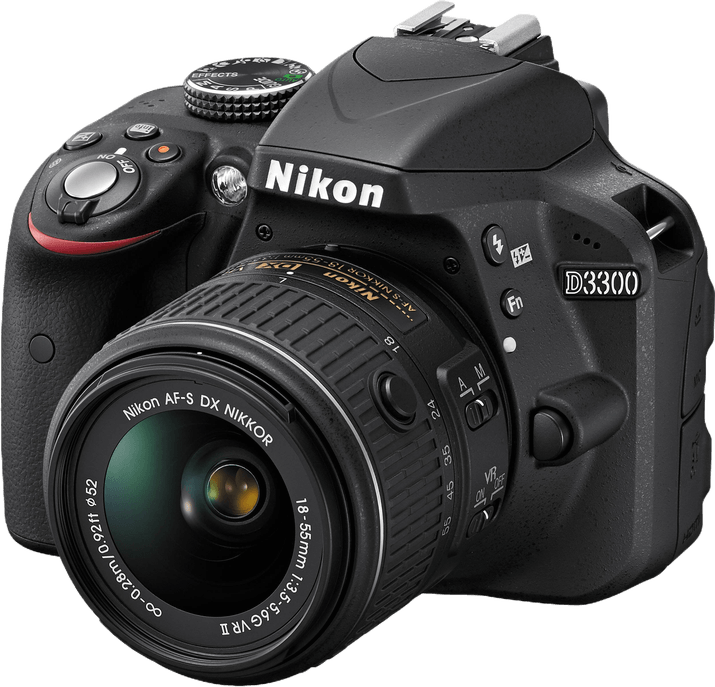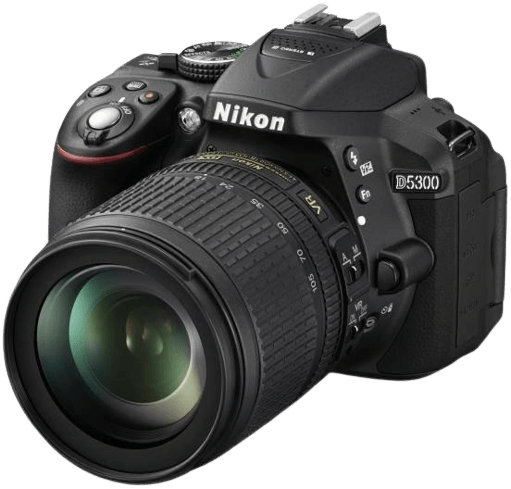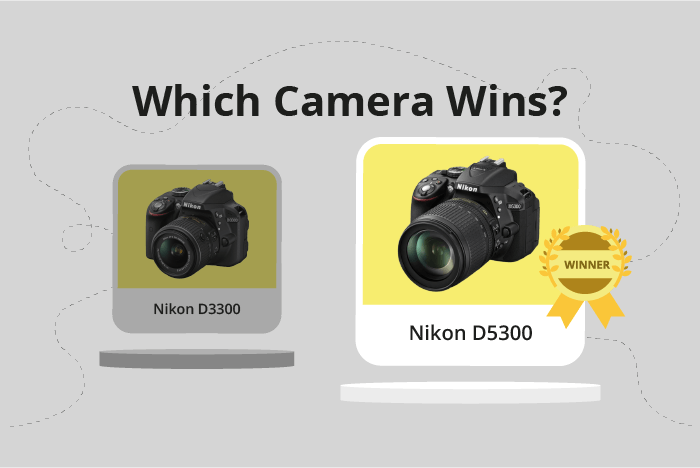Nikon D3300 vs D5300 Comparison
Nikon D3300

Nikon D5300

The Nikon D5300 takes the lead with a score of 57/100, just 2 points ahead of the Nikon D3300 at 55/100. Both cameras are DSLR models, released in 2013 and 2014, respectively, and share the same camera size of 124 x 98 x 76mm. The D5300, although slightly heavier at 480g, offers a higher overall score due to its superior performance.
The Nikon D3300, with a launch price of $650, is more affordable than the D5300, which was launched at $800. This makes the D3300 a better choice for budget-conscious buyers. However, the D5300’s higher score indicates that it provides better value for the additional cost.
Taking all factors into consideration, the Nikon D5300 is the better camera of the two. While the Nikon D3300 is a more budget-friendly option, the D5300 offers better performance, justifying its higher price and score.
Nikon D3300 vs D5300 Overview and Optics
The Nikon D5300 wins in the optics comparison with a score of 65/100, while the Nikon D3300 scores 64/100. Both cameras share several specifications, such as 24.2 megapixels, 5 shooting speed, CMOS sensor type, Expeed 4 processor, APS-C sensor size, Nikon F DX lens mount, and no image stabilization.
The Nikon D5300 has a slightly better performance due to its DXOMARK score of 83 for the sensor, compared to the D3300’s sensor score of 82. This one-point difference contributes to the D5300’s overall better optics score. The higher sensor score means the D5300 can capture images with marginally better quality, making it more suitable for photographers who prioritize image quality.
However, the Nikon D3300 still has its advantages, despite having a lower optics score. It offers the same shooting speed, megapixels, and lens compatibility as the D5300, making it a good option for photographers who do not require the highest sensor score. The Nikon D3300 remains a reliable choice for those looking for a camera with solid performance and similar specifications to the D5300.
Taking into account the slight difference in sensor scores, the Nikon D5300 is the better choice for photographers who prioritize image quality. However, the Nikon D3300 remains a strong contender due to its shared specifications with the D5300, making it a suitable option for those who do not require the highest sensor score.
Nikon D3300 vs D5300 Video Performance
The Nikon D5300 emerges as the winner in the video capabilities comparison with a score of 70, while the Nikon D3300 scores 14 points lower at 56. Both cameras share some common specifications, such as a maximum video resolution of Full HD and video dimensions of 1920 x 1080. They also both offer a maximum video frame rate of 60fps.
The primary advantage of the Nikon D5300 is its built-in time-lapse functionality. This feature allows users to create stunning time-lapse videos without the need for additional equipment or software. The D3300, on the other hand, does not have this built-in feature. This difference alone contributes to the higher score of the D5300 in video capabilities.
While the Nikon D3300 may not have the built-in time-lapse functionality, it still offers the same maximum video resolution, dimensions, and frame rate as the D5300. This means that the D3300 can still produce high-quality videos, but without the added benefit of time-lapse functionality.
Taking all of these factors into consideration, it is clear that the Nikon D5300 is the superior choice for video capabilities due to its built-in time-lapse feature. The Nikon D3300, however, still remains a viable option for those who do not require time-lapse functionality and are more focused on capturing high-quality videos at the same resolution and frame rate as the D5300.
Nikon D3300 vs D5300 Features and Benefits
The Nikon D5300 wins the feature comparison with a score of 46/100, while the Nikon D3300 trails with a score of 41/100. Both cameras share some specifications, like a 3-inch screen size for the D3300 and a 3.2-inch screen size for the D5300. Neither camera has a touchscreen or Bluetooth capabilities.
The D5300 outshines the D3300 in several aspects. The D5300 has a higher screen resolution with 1,037,000 dots, compared to the D3300’s 921,000 dots. This difference results in a more detailed and clear display on the D5300. Additionally, the D5300 has a flip screen, providing more flexibility for shooting in various angles and situations. The D5300 also includes GPS and WIFI capabilities, which make geotagging and transferring photos more convenient.
On the other hand, the D3300 does not offer any superior features compared to the D5300. Its lower score reflects its fewer features and capabilities. The D3300’s lack of a flip screen, GPS, and WIFI make it less versatile and user-friendly than the D5300.
Considering these points, the Nikon D5300 proves to be the better choice among the two cameras, as it offers more advanced features and capabilities than the Nikon D3300. The higher screen resolution, flip screen, GPS, and WIFI make the D5300 a more versatile and convenient option for photographers. While the D3300 may still appeal to some users, the D5300’s additional features make it a more attractive option for those seeking a camera with more advanced capabilities.
Nikon D3300 vs D5300 Storage and Battery
The Nikon D3300 outperforms the Nikon D5300 in the storage and battery category, scoring 32/100 compared to the D5300’s 29/100. Both cameras share some common specifications in this area, including having one memory card slot and accepting SD, SDHC, and SDXC cards. Additionally, both cameras use the same battery type, EN-EL14a, and neither offers USB charging.
The D3300’s advantage lies in its longer battery life, providing 700 shots per charge compared to the D5300’s 600 shots. This difference makes the D3300 more suitable for extended shooting sessions without needing to replace or recharge the battery.
Though the D5300 falls short in battery life, it does not have any specific advantages in the storage and battery category. The cameras are equal in memory card compatibility and charging options.
In this comparison, the Nikon D3300 emerges as the better choice for storage and battery capabilities due to its longer battery life. The Nikon D5300 does not offer any distinct advantages in this area, making the D3300 a more reliable option for photographers who prioritize battery performance.
Nikon D3300 vs D5300 – Our Verdict
Are you still undecided about which camera is right for you? Have a look at these popular comparisons that feature the Nikon D3300 or the Nikon D5300:

